 Mysteries
Mysteries  Mysteries
Mysteries  History
History 10 Surprising Stories About the Texas Rangers
 Humans
Humans 10 Philosophers Who Were Driven Mad by Their Own Theories
 Miscellaneous
Miscellaneous 10 Video-Game-Worthy Weapons and Armors from History
 Weird Stuff
Weird Stuff 10 Psychics Who Accurately Predicted Wartime Events
 The Arts
The Arts 10 Pieces of Art Inspired by a Broken Heart
 Health
Health 10 Science Fiction-Sounding New Medical Treatments
 History
History 10 Surprising Facts About the Father of Submarine Warfare
 Space
Space Ten Astonishing New Insights into Alien Worlds
 Weird Stuff
Weird Stuff 10 Bizarre Summer Solstice Rituals Still Practiced Today
 Mysteries
Mysteries Top 10 Haunting Facts About the Ghost Ship MV Alta
 History
History 10 Surprising Stories About the Texas Rangers
 Humans
Humans 10 Philosophers Who Were Driven Mad by Their Own Theories
Who's Behind Listverse?

Jamie Frater
Head Editor
Jamie founded Listverse due to an insatiable desire to share fascinating, obscure, and bizarre facts. He has been a guest speaker on numerous national radio and television stations and is a five time published author.
More About Us Miscellaneous
Miscellaneous 10 Video-Game-Worthy Weapons and Armors from History
 Weird Stuff
Weird Stuff 10 Psychics Who Accurately Predicted Wartime Events
 The Arts
The Arts 10 Pieces of Art Inspired by a Broken Heart
 Health
Health 10 Science Fiction-Sounding New Medical Treatments
 History
History 10 Surprising Facts About the Father of Submarine Warfare
 Space
Space Ten Astonishing New Insights into Alien Worlds
 Weird Stuff
Weird Stuff 10 Bizarre Summer Solstice Rituals Still Practiced Today
10 Lesser-Known Facts About Superheroes
Prometheus, Hercules, Thor, Robin Hood, Superman. From the very beginnings of human history, we have imagined stories about prodigious individuals who were willing to use their divine gifts to fight for the defenseless. As the modern variant of these almighty figures, superheroes invade our culture to the core. Everyone knows about superheroes, welcoming their presence through mass entertainment and cultural globalization.
But as often happens in many other fields, people ignore many details about these iconic characters. The truth is that the story behind the birth and popularity of superheroes is as interesting as the tales that the superheroes themselves can tell. That story is what this list is about. Here we will show you unfamiliar facts about the past, present, and future of superhero lore.
10 What Are The Origins Of Superheroes?

Superhero stories have been around for millennia. For example, the ancient Greeks told stories about characters with extraordinary abilities as a result of their connection with the gods who could bless or doom mankind with their actions.
These myths existed for the purpose of explaining real natural phenomena at a time when knowledge about the world was fairly limited. But what about modern superheroes? What inspired their stories? Well, it may be surprising to find out that today’s superhuman characters and those of ancient times are not so separated from each other.
The Flash, created in 1940, was initially based on the Roman god Mercury, the swift messenger. Wonder Woman was obviously inspired by the Greek legend of the Amazon warriors.
DC’s Aquaman and Marvel’s Namor are based on the Atlantis civilization described by the Greek philosopher Plato. Thor is inspired by the homonym god of Norse mythology. So it is interesting that many of the first created superheroes are inspired by mythological figures and cultures.
Superman, created by the artists Jerry Siegel and Joe Shuster, is one of the most complex characters when it comes to determining the influences behind his creation. Superman is partially inspired by characters from other stories of the time, such as “John Carter of Mars.”[1]
As Siegel and Shuster were children of Jewish immigrants, it is also believed that Superman was a reimagining of Jewish myths, especially the myth of the golem. Just as the golem was an unstoppable being created to free the oppressed, Superman is an all-powerful savior who came to rescue the innocent in the midst of a cruel world.
In short, the fictional superheroes of our times are a modernized version of the legends that our ancestors believed were real. But that is not coincidence.
Such myths often used the same narrative model to tell the story of a certain individual destined to become a hero and fight evil. That type of story proved so effective at captivating people that it is still used today on everything from comics to movies, and superheroes are no exception.
9 Superheroes Have Been Used As War Icons
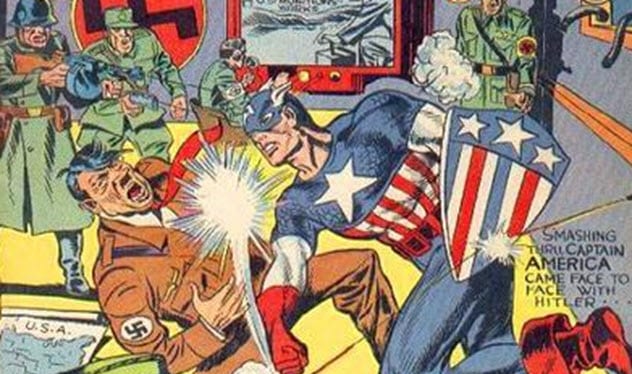
Scientific studies show that modern superheroes have a great psychological impact on people of all kinds and ages. For this reason, these characters are easily seen as pillars of hope and optimism, exponents of great values in our culture.
But when the social situation changes, superheroes also acquire a new purpose. Knowing the potential to influence people, governments have used comic book characters to motivate the population to take action and fight for their country on the battlefield.
The most evident case of this reality is the character of Captain America.[2] His first comic came out in March 1941, nine months before the United States entered World War II at its most critical point. The idea of a superhero dressed in the American flag while defeating Nazis with his bare hands was what the population needed at that moment.
That is why it is no coincidence that the comics of this character were the most read of the publisher Timely (later Marvel Comics) during the war with a million copies sold per month. Even US soldiers read the stories of the superhero while on the battlefield.
Captain America’s comics included things like patriotic illustrations or moments in the story where the superhero asked the reader to buy war bonds. Meanwhile, Superman was also used to encourage the purchase of war bonds.
In 1969, after soldiers asked for Superman to appear on the battlefield, DC published a comic in which he goes to the Vietnam War. In 2005, Marvel collaborated with the Pentagon to distribute free comics to a million troops under a campaign called “America Supports You.”
In 2011, Legendary Comics released a graphic novel called Holy Terror in which a Batman-esque vigilante fights Islamic terrorists. So, somehow, superheroes are inherently good to be used as war propaganda.
8 They Have Also Been Inspired By Real People
Publishers do not always rely on mythological characters and legends to create their superheroes. For various reasons, these figures are sometimes built around real people. Perhaps, artists see some known person as the ideal model to create a new superhero. Other times, certain individuals in the real world have such outstanding lives that it is easy to give them superhuman features in a comic.
For that last reason, we have the example of Tony Stark/Iron Man whose creation in 1963 was based on the US billionaire Howard Hughes. Artists in DC wanted to make a character that had the carefree, misaligned appearance of the famous musician Sting. Presumably in 1985, that is how the supernatural antihero named John Constantine was born.
It is well-known that the personality of Professor X, the leader of the Marvel’s X-Men, was inspired by the activist and preacher Martin Luther King Jr. But the character is physically based on the Oscar-winning actor Yul Brynner.
Meanwhile, the actor Samuel L. Jackson was taken as the base to remake Nick Fury, the founder of the Avengers and director of the S.H.I.E.L.D. organization. At first, Jackson did not even know that Marvel used him as inspiration to create the character, but he still agreed to play Fury’s movie version.
Real people don’t just serve as inspiration for superheroes, though. The tyrannical Darkseid, one of the most powerful villains in the DC stories, bases his personality on Adolf Hitler, one of the most famous tyrants in recent history.[3]
7 Superheroes Are Now A University Career
Some have said that superheroes are for children. Others say that superheroes are entertainment that cannot be taken too seriously. But now, that is changing.
With the huge popularity that the superhero genre has today, many academic institutions are starting to adopt these characters as an object of study in their courses. After all, superhero stories are a mix of art, literature, and science from which more than just entertainment can be obtained.
Since 2015, the Smithsonian Institution has offered an online course on superheroes through EdX, a learning platform founded by MIT and Harvard. The course is titled “The Rise of Superheroes and Their Impact On Pop Culture” and covers the entire history of the superhero genre from its origins in 1938 to the present day.[4]
Two of its teachers are Stan Lee, the well-known artist of Marvel Comics, and Michael Uslan, producer of the Batman films since 1989. Although Lee died in November 2018, his signature is still on the certificate issued at the end of the course.
Meanwhile, among its available disciplines, the University of Oregon has one called “Comic Studies.” It focuses on the technical aspects of comics, such as the drawings and storytelling. On the other hand, the University of Minnesota has a course on “the physics of superheroes”—that is, the scientific facts that writers used to explain the powers of the characters.
It is true that we could doubt how good these courses are in preparing a student to get a job compared to other careers. But after studying these disciplines, you could call yourself a “superhero scholar,” which sounds pretty awesome.
6 The Day Superheroes Faced A Real-Life Enemy
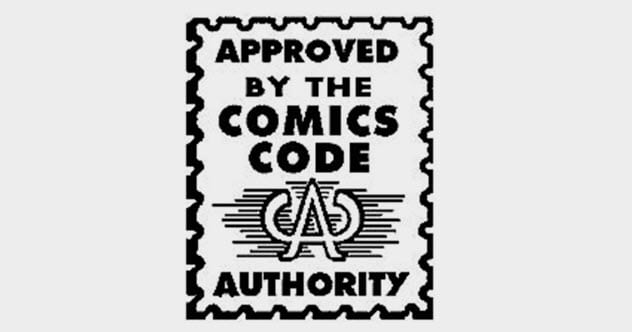
From their beginnings in the late 1930s, superhero comics told simple stories of hope where good always triumphed over evil and the characters did not have complex backgrounds. But at the end of the 1940s, they began to deal with controversial issues for those times in terms of gender and racial diversity. Then horror and gore also entered their stories, and the American people began to see these fictions with bad eyes.
Many parents believed that the comics were harmful to their children, while others maintained that there was a correlation between the content of comic books and the increase in delinquency. Many people even organized public comic book burnings in several cities across the United States.
Meanwhile, psychiatrist Fredric Wertham began giving talks and publishing studies that supported all this collective fear, something that ultimately came to the ears of the US government. Congress held hearings to consider Wertham’s arguments. Although the government did not go beyond that meeting, the event was televised throughout the country.
Many publishers had to close due to the drastic decline in sales. Then the surviving big comic book publishers decided to take measures to protect the industry. In 1954, they joined to form the Comics Code Authority (CCA) which dictated what a comic could and could not show.
For example, comics could not show vampires or werewolves and could not contain sexual references. Good always had to come out victorious, and villains could not be represented in such a way that readers could empathize with them. If a comic complied with these and other conditions, the CCA allowed it to have its stamp on the cover. The truth is that distributors only accepted comics approved by the CCA.
Although these limitations allowed the survival of the industry, sales continued to decline. Then, in the early 1970s, the publisher Marvel challenged the Code by issuing comics with ruthless villains and political references.
In 1971, Marvel editor Stan Lee released several issues of Spider-Man touching on topics such as drug abuse, a movement imitated by DC. These changes were well received at a time when US culture was experiencing a turning point and many taboos were no longer such.
In subsequent years, the Comics Code was rewritten several times. But its implementation gradually collapsed, and publishers sold more and more comics without the Code seal.[5]
Finally, in 2011, the CCA stopped its functions. So the superhero industry had to face a real-life villain. It turned out to be a joint effort between the authorities and a few people who were full of paranoid fear and blamed the comics for all evils.
5 Superheroes Are The Most Profitable Genre Of All
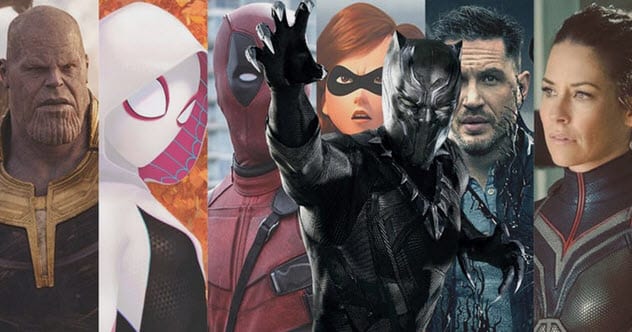
It is not a surprise that superhero movies are economically profitable. On average, a horror film makes almost $20 million in the domestic box office. In contrast, an average superhero movie can gross up to eight times that amount in the same market.
Undoubtedly, the genre of “supers” is more alive than ever. But it is lesser known that the commercial monster of superhero movies generates more money than almost any other entertainment conglomerate in the world.
In 2017, the superhero genre was the most successful of all, with revenues of $4.8 billion between eight major films of Marvel, DC, and Saban. In 2018, the situation repeated with even greater earnings.
At the end of 2018, the income generated by the eight superhero films with theatrical releases that year was between $7.5 billion and $8 billion. In fact, the genre represented 25.5 percent of total ticket sales in the United States.[6]
But superheroes are not only winners in the film industry. By 2018, the Marvel Cinematic Universe far surpassed any other movie franchise in terms of revenue. If we combine all the movies about Marvel characters, the brand represents the highest-grossing media franchise in the world, surpassing even the Pokemon franchise and its $59 billion earnings.
With seven major releases of the genre in 2019, experts believe that the situation will only continue to improve for the superhero industry.
4 The North Korean Superheroes

For a country that does not even have light at night, it would be easy to think that North Korea has not been reached by the superhero culture. After all, fictional characters such as superheroes are more typical of Western culture, which North Korea seems to despise strongly.
But the truth is that even North Koreans have been seduced by the idea of having a superhuman figure to admire. Of course, they have to maintain their “anti-imperialist” posture. So, instead of following foreign superheroes, they have decided to create their own.
In Korea, there has been the story of a hero named Hong Gildong for centuries. In short, this is the Korean version of Robin Hood. In 1986, North Korea released its own film about the character set in feudal Korea. In it, Hong Gildong is an alienated man who becomes a vigilante, protecting innocent people from bad guys and even freeing his city from enemy forces.
On the other hand, images of a supposed North Korean film in the works were leaked in 2014. These images show what seems to be an original superhero wearing a military uniform, riding a winged horse, and using a torch as a weapon. The superhero, like a North Korean version of Superman, attacks the “bad guys,” who turn out to be the Americans, by throwing their gold into the sea and thus giving a blow to capitalism.[7]
We also know of a North Korean comic book from 2001 called Blizzard in the Jungle. In the story, a doctor named Kim Yeong-hwan uses the wisdom of his leader Kim—and the power conferred by a plant grown in Korea—to help the survivors of a plane crash.
But beyond all this, there is no greater superhero for the North Koreans than their own leader, Kim Jong Un. According to local news, the controversial ruler can control climate as well as cure all diseases. Last but not least, he has found unicorns.
3 They Are Everywhere
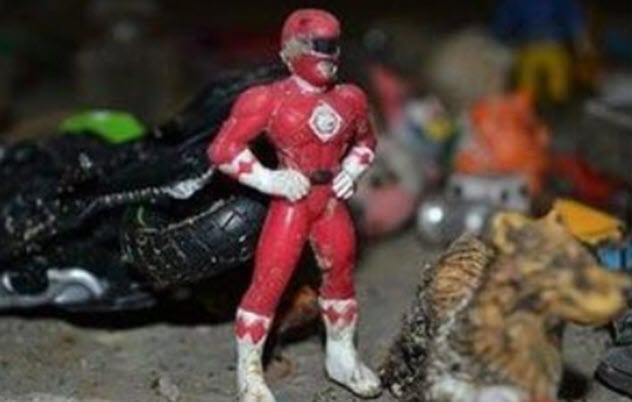
In recent decades, the superhero industry has been covered by a large chunk of the mass media around the world. Nowadays, it is not difficult to find out about a new release in the genre. The marketing for every new superhero movie goes from television ads to giant billboards on buildings.
But the legacy of superheroes can be found far beyond the entertainment and the publicity that surrounds us. We can say that superheroes are truly everywhere, permeating our culture. Maybe we would do well to see some examples.
Two of Superman’s first published comics, one of which sold for $175,000, were found inside the walls of an old house. There is also the Power Rangers action figure that was blocking sewer pipes in England in 2017 and had to be removed.
Meanwhile, actors disguised as the family of the Japanese superhero Ultraman traveled to a volcano in Hawaii to shoot a promotional video. On a completely different topic, several superhero games from Marvel and DC are on the list of video games that Guantanamo prisoners are allowed to play.
It is interesting to note that superheroes can also be found in space. Astronauts on the International Space Station (ISS) have a collection of Marvel and DC movies to watch in their spare time. Mission patches featuring Groot and Rocket Raccoon from Marvel’s Guardians of the Galaxy were also sent to the ISS in 2017.
If you consider Buzz Lightyear from Toy Story a superhero character, he also flew into space in 2008. And since we are talking about Buzz Lightyear, a toy of the character was found in a patient’s rectum, which is disgusting, but it proves that superheroes are really everywhere.[8]
2 Superheroes May Not Be Good For Children
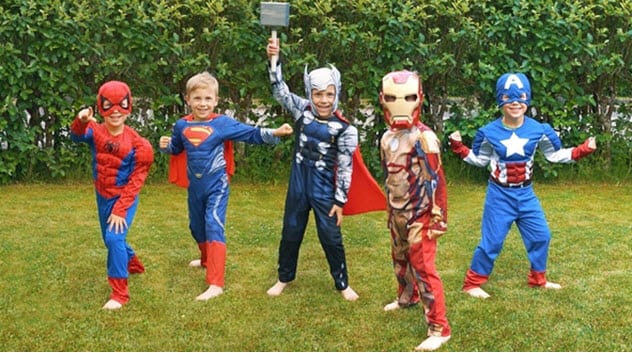
Over the years, there have been multiple debates about whether superheroes are good or bad examples for children. A 2007 study showed that the superhero culture makes children believe that certain risky behaviors are normal, occasionally leading some youngsters to suffer serious physical injuries.
In June 2007, another study on the subject was published, stating that children who liked superheroes said they were more sociable with others. Meanwhile, a more recent study published in 2017 found that superhero entertainment causes children to become more aggressive and less sociable.
Despite the researchers’ statements, some adults have felt that they had to do something to protect the little kids. In May 2013, a preschool from Pennsylvania distributed pamphlets to notify parents that their children could no longer play superheroes in the institution because they apparently hurt each other.
In 2016, Australian childcare centers asked parents not to send their children dressed as superheroes as they were prone to perform self-harming actions. In any case, some decisions of this kind may have gone too far.[9]
Also in 2013, an elementary school forbade children to wear superhero costumes on Halloween because they could be “scary” for some of their classmates. Two years later, another school prevented a girl from carrying her Wonder Woman lunch box. The institution claimed that it did not admit images of “violent characters” and that “superheroes certainly fall into that category.”
We can agree or disagree with this kind of attitude from adults. But it is clear that more studies are needed to determine the real impact of superheroes on the delicate psyche of little children.
1 Why Are Their Films So Successful?
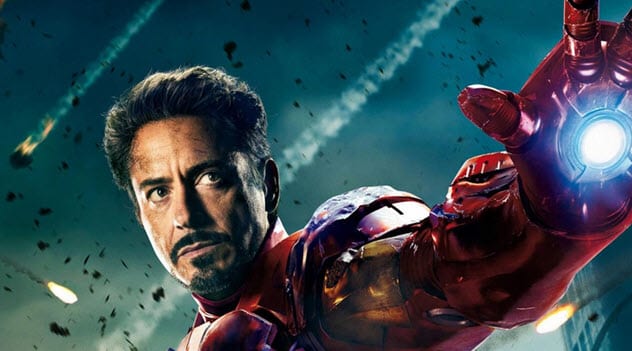
Superheroes have been portrayed in movies for around a century now, but they have not always been as well received. Just as superhero comics have gone through stages in which they were more or less read, superhero movies have also experienced ups and downs in terms of popularity.
As we previously saw, superheroes are now going through their best moment in the film industry. But what caused this leap in the acceptance of superhero films? Why are moviegoers now receiving superhuman characters better than ever?
Well, we can point to several reasons. First, it is easy to see that the superheroes in today’s movies are much more relatable than those in old films. That is largely because the stories in the movies now show more humanized characters. People tend to be more interested in those heroes who, even with their gifts, must fight against the ordinary problems of life because anyone can identify with them.[10]
Second, most superhero films in our times are within what is known as a “shared universe.” Brands like Marvel, among others, often tell stories in which the characters interact with each other in the same world throughout different movies. This creates a sense of continuity that makes fans eager to see what the next chapter in the franchise will be about.
Another important point is the improvement that the film industry has experienced in the field of visual effects. For example, director James Cameron waited 15 years before releasing his famous film Avatar because he believed that filmmaking technology was not sufficiently developed before then.
And since we generally do not see people flying or throwing energy beams of their hands in real life, the use of special effects is inherent in the stories of superheroes. That is why superhero movies in past decades had to be limited to stories that did not require too much budget if they wanted to look realistic.
But thanks to today’s technology, directors can unleash their imaginations and create superhero movies with otherworldly stories that appeal to the public.
Brian is an economy student, graphic artist, science enthusiast, and founder of “A Strange Place Called Knowledge.” You can reach the site here
Read bizarre stories about creepy and offensive superheroes on 10 Of The Creepiest Things Superheroes Have Done and 10 Of The Most Offensive Superheroes In The History Of Comics.





![11 Lesser-Known Facts About Mass Murderer Jim Jones [Disturbing Content] 11 Lesser-Known Facts About Mass Murderer Jim Jones [Disturbing Content]](https://listverse.com/wp-content/uploads/2020/09/jonestown2-copy-150x150.jpg)


